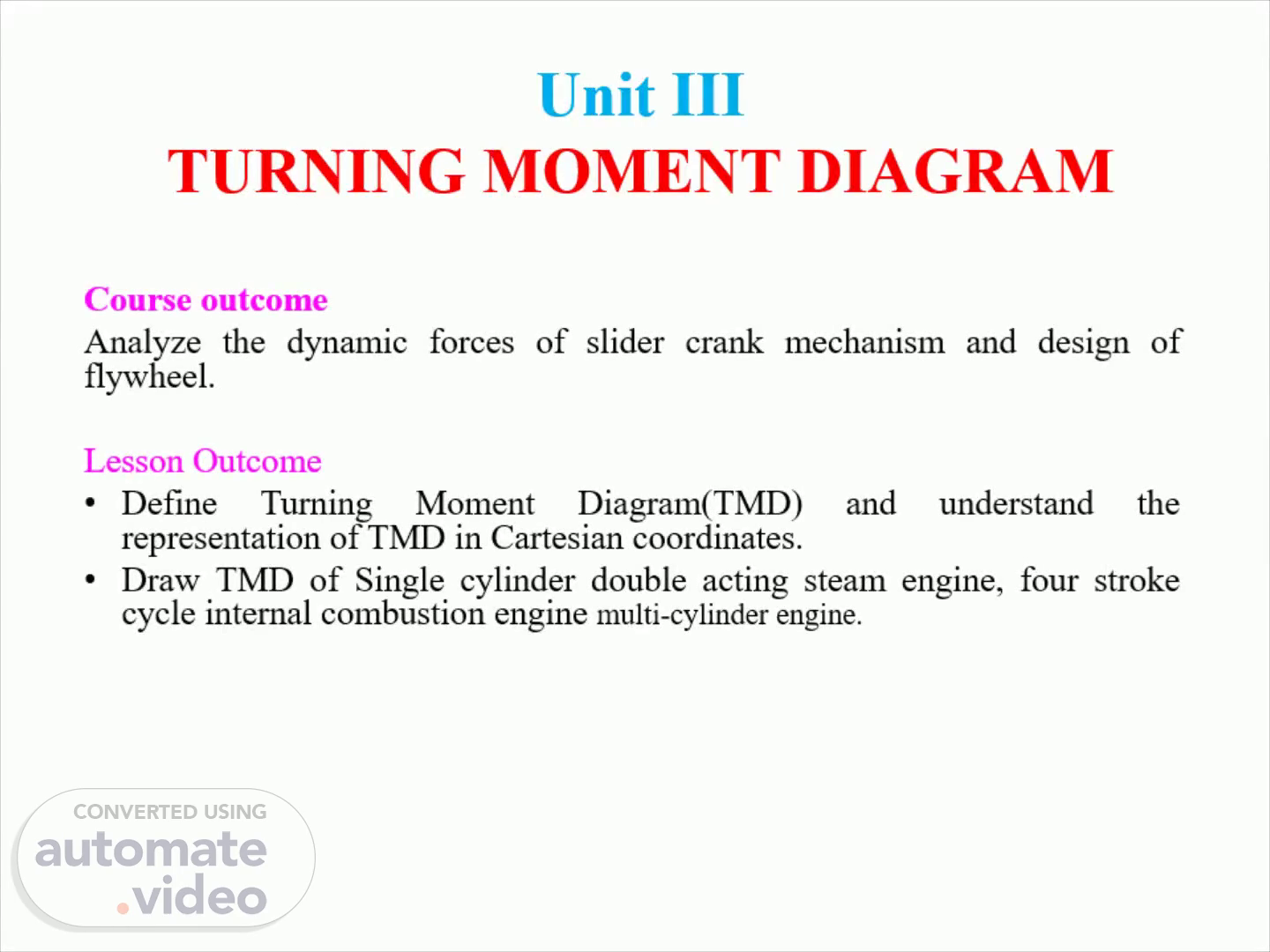
Unit III TURNING MOMENT DIAGRAM
Scene 1 (0s)
Unit III TURNING MOMENT DIAGRAM. Course outcome Analyze the dynamic forces of slider crank mechanism and design of flywheel. Lesson Outcome Define Turning Moment Diagram(TMD) and understand the representation of TMD in Cartesian coordinates. Draw TMD of Single cylinder double acting steam engine, four stroke cycle internal combustion engine multi-cylinder engine..
Scene 2 (16s)
TURNING MOMENT DIAGRAM. The turning moment diagram (also known as crank effort diagram) is the graphical representation of the turning moment or crank effort for various positions of the crank. It is plotted on cartesian co-ordinates, in which the turning moment is taken as the ordinate (y-axis) and crank angle as abscissa (x-axis)..
Scene 3 (34s)
Importance of Turning Moment Diagram. The area of the turning moment diagram represents the work done per revolution. The work done per cycle when divided by crank angle per cycle gives the mean torque (T m ). The mean torque (T m ) multiplied by the angular velocity of the crank gives the power consumed by the machine or power developed by an engine. The area of the TMD above the mean torque line represents the excess energy that may be stored in the flywheel, which helps in design the dimensions and mass of the flywheel..
Scene 4 (59s)
TURNING MOMENT DIAGRAM (cont.). The turning moment on the crankshaft.
Scene 5 (1m 14s)
TURNING MOMENT DIAGRAM (cont.). b 900 Mean resisting d torque q 1800 r 2700 s 3600 — Crank ange Fig. 16.1. Turning moment diagram for a single cylinder, double acting steam engine..
Scene 6 (1m 34s)
TURNING MOMENT DIAGRAM (cont.). Fluctuations of energy The variations of energy above and below the mean resisting torque line are called fluctuations of energy. The areas BbC , CcD , DdE , etc. represent fluctuations of energy..
Scene 7 (1m 53s)
TURNING MOMENT DIAGRAM (cont.). Maximum fluctuation of energy The difference between the maximum and the minimum energies is known as maximum fluctuation of energy. The engine has a maximum speed either at q or at s . This is due to the fact that the flywheel absorbs energy while the crank moves from p to q and from r to s. On the other hand, the engine has a minimum speed either at p or at r. The reason is that the flywheel gives out some of its energy when the crank moves from a to p and q to r..
Scene 8 (2m 23s)
Determination of Maximum Fluctuation of Energy. A turning moment diagram for a multi-cylinder engine is shown by a wavy curve in Fig.16.4. The horizontal line AG represents the mean torque line. Let a1, a3, a5 be the areas above the mean torque line and a2, a4 and a6 be the areas below the mean torque line. These areas represent some quantity of energy which is either added or subtracted from the energy of the moving parts of the engine..
Scene 9 (3m 2s)
Determination of Maximum Fluctuation of Energy (cont.).
Scene 10 (3m 13s)
Coefficient of Fluctuation of Energy. It may be defined as the ratio of the maximum fluctuation of energy to the work done per cycle. Mathematically, coefficient of fluctuation of energy..
Scene 11 (3m 39s)
Coefficient of Fluctuation of Energy (cont.). The mean torque (T where where ) in N-m may be obtained by using the following relation : Px60 P P = Power transmitted in watts, N = Speed in r.p.m., and (t) = Angular speed in rad/s = 2 RN/6() 2. The work done per cycle may also obtained by using the following relation : Px60 Work done per cycle = n n = Number of working strokes per minute, = N, in case of steam engines and two stroke internal combustion engines, = N 12, in case of four stroke internal combustion engines..